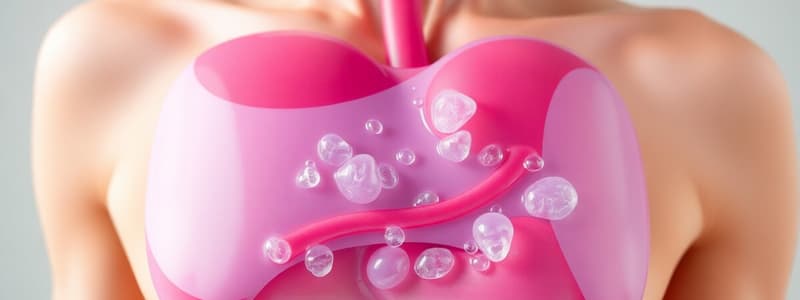Podcast
Questions and Answers
What is the primary physiological mechanism responsible for the fluid retention seen in SIADH?
What is the primary physiological mechanism responsible for the fluid retention seen in SIADH?
- Decreased production of aldosterone
- Increased renal excretion of sodium
- Enhanced permeability of the renal collecting duct to water (correct)
- Impaired thirst sensation
Which of the following is NOT a common clinical manifestation of SIADH?
Which of the following is NOT a common clinical manifestation of SIADH?
- Hypokalemia
- Headache
- Hyponatremia
- Increased urine output (correct)
Which one of the following conditions is most commonly associated with SIADH?
Which one of the following conditions is most commonly associated with SIADH?
- Hypothyroidism
- Hypertension
- Cancer, particularly small cell lung cancer (correct)
- Diabetes insipidus
What laboratory finding confirms the diagnosis of SIADH?
What laboratory finding confirms the diagnosis of SIADH?
What is the typical effect of SIADH on glomerular filtration rate?
What is the typical effect of SIADH on glomerular filtration rate?
Why is SIADH more likely to be self-limiting when caused by head trauma or drugs?
Why is SIADH more likely to be self-limiting when caused by head trauma or drugs?
Which of the following clinical manifestations of SIADH may occur as serum sodium levels fall below 120 mEq/L?
Which of the following clinical manifestations of SIADH may occur as serum sodium levels fall below 120 mEq/L?
What is the primary nursing intervention for a patient with SIADH?
What is the primary nursing intervention for a patient with SIADH?
What is the recommended fluid restriction for patients with mild hyponatremia and a serum sodium level greater than 125 mEq/L?
What is the recommended fluid restriction for patients with mild hyponatremia and a serum sodium level greater than 125 mEq/L?
Which of the following medications should be avoided or discontinued in patients with SIADH?
Which of the following medications should be avoided or discontinued in patients with SIADH?
What is the recommended treatment for severe hyponatremia (less than 120 mEq/L) with neurologic manifestations, such as seizures?
What is the recommended treatment for severe hyponatremia (less than 120 mEq/L) with neurologic manifestations, such as seizures?
What is the maximum rate of increase in serum sodium level recommended in the first 24 hours when treating hyponatremia?
What is the maximum rate of increase in serum sodium level recommended in the first 24 hours when treating hyponatremia?
Which of the following is a possible complication of rapidly correcting hyponatremia?
Which of the following is a possible complication of rapidly correcting hyponatremia?
What is the recommended fluid restriction for patients with chronic SIADH?
What is the recommended fluid restriction for patients with chronic SIADH?
Which of the following drugs is NOT approved for use in the United States to treat euvolemic hyponatremia?
Which of the following drugs is NOT approved for use in the United States to treat euvolemic hyponatremia?
Which of the following conditions is NOT a potential cause of SIADH listed in Table 54.3?
Which of the following conditions is NOT a potential cause of SIADH listed in Table 54.3?
Which of the following medications can cause SIADH?
Which of the following medications can cause SIADH?
Besides loop diuretics, which electrolyte may need to be supplemented for patients with SIADH, especially if taking loop diuretics?
Besides loop diuretics, which electrolyte may need to be supplemented for patients with SIADH, especially if taking loop diuretics?
Flashcards
SIADH
SIADH
Syndrome of Inappropriate Antidiuretic Hormone; excessive ADH secretion.
ADH
ADH
Antidiuretic Hormone; regulates water balance in the body.
Dilutional hyponatremia
Dilutional hyponatremia
Low sodium concentration due to excess water retention.
Cerebral edema
Cerebral edema
Signup and view all the flashcards
Diagnosis of SIADH
Diagnosis of SIADH
Signup and view all the flashcards
Common causes of SIADH
Common causes of SIADH
Signup and view all the flashcards
Clinical manifestations of SIADH
Clinical manifestations of SIADH
Signup and view all the flashcards
Nursing care for SIADH
Nursing care for SIADH
Signup and view all the flashcards
Fluid Restriction
Fluid Restriction
Signup and view all the flashcards
Furosemide
Furosemide
Signup and view all the flashcards
Demeclocycline
Demeclocycline
Signup and view all the flashcards
Seizure Precautions
Seizure Precautions
Signup and view all the flashcards
Hypertonic Saline
Hypertonic Saline
Signup and view all the flashcards
Osmotic Demyelination Syndrome
Osmotic Demyelination Syndrome
Signup and view all the flashcards
Conivaptan
Conivaptan
Signup and view all the flashcards
Tolvaptan
Tolvaptan
Signup and view all the flashcards
Chronic SIADH Management
Chronic SIADH Management
Signup and view all the flashcards
Symptoms of Electrolyte Imbalances
Symptoms of Electrolyte Imbalances
Signup and view all the flashcards
Study Notes
Syndrome of Inappropriate Antidiuretic Hormone (SIADH)
-
Etiology and Pathophysiology: SIADH is caused by excessive antidiuretic hormone (ADH) production despite normal or low plasma osmolarity. ADH increases kidney water reabsorption, leading to fluid retention, decreased plasma osmolality, increased glomerular filtration rate, and dilutional hyponatremia. Features include fluid retention, low serum osmolality, low sodium (hyponatremia), low chloride (hypochloremia), and concentrated urine.
-
Common Causes: Cancer, especially small cell lung cancer, is the most frequent cause. Other causes include head trauma or drug use (often self-limiting) and tumors or other metabolic diseases (often chronic).
-
Clinical Manifestations: Early symptoms include thirst, dyspnea, fatigue, and mild hyponatremia (muscle cramping, irritability, headaches). Severe hyponatremia (typically <120 mEq/L) results in vomiting, abdominal cramps, muscle twitching, lethargy, confusion, seizures, and coma due to cerebral edema. Low urine output and increased body weight are also present.
-
Diagnosis: SIADH is diagnosed by comparing urine and serum osmolality. Dilutional hyponatremia is characterized by serum sodium <135 mEq/L, serum osmolality <280 mOsm/kg, and urine specific gravity >1.030. A serum osmolality significantly lower than urine osmolality indicates inappropriate urine concentration despite dilute serum.
Interprofessional and Nursing Care
-
Assessment: Patients at risk for or with confirmed SIADH should be assessed for low urine output with high specific gravity, sudden weight gain without edema, or decreased serum sodium. Monitor intake/output, vital signs, cardiac/pulmonary sounds, and obtain daily weights.
-
Monitoring: Observe for symptoms of hyponatremia such as seizures, headache, vomiting, and decreased neurological function.
-
Treatment (Mild Cases): If symptoms are mild and serum sodium is >125 mEq/L, fluid restriction to 800-1000 mL/day may be the only treatment. This aims to reduce fluid overload, increasing serum sodium and osmolality. Oral care and distractions to cope with thirst from restriction are helpful.
-
Treatment (Moderate Cases): Loop diuretics (e.g., furosemide) may be used to promote diuresis, but serum sodium must be at least 125 mEq/L. Potassium, calcium, and magnesium supplements may be needed due to diuretic effects. Demeclocycline can also be used to block ADH effect on the kidneys.
-
Treatment (Severe Cases): For severe hyponatremia (<120 mEq/L) with neurological symptoms, IV hypertonic saline (3% sodium chloride) is given very cautiously. Sodium levels should not increase by more than 8-12 mEq/L per 24 hours to prevent osmotic demyelination syndrome. Additional fluid restriction (500 mL/day) may be required in severe cases.
-
Vasopressin Receptor Antagonists: For euvolemic hyponatremia in hospitalized patients, vasopressin receptor antagonists (conivaptan or tolvaptan) can be used to block the activity of ADH. These drugs should be avoided in liver disease, as they can worsen liver function.
-
Chronic Management: Encourage self-management in patients with chronic SIADH. Recommend a fluid restriction of 800-1000 mL/day. Offer alternative thirst relief measures (ice chips, sugarless gum). Teach the importance of supplementing sodium and potassium intake, especially if using loop diuretics, and the need for daily weight monitoring. Inform them about symptoms of fluid and electrolyte imbalances.
-
General Precautions: In patients with alteration in sensorium or seizures, initiate seizure and fall precautions. Maintain the head of the bed flat or elevated no more than 10 degrees to promote venous return. Promote skin and joint integrity with frequent turning, repositioning, and range-of-motion exercises.
Studying That Suits You
Use AI to generate personalized quizzes and flashcards to suit your learning preferences.




